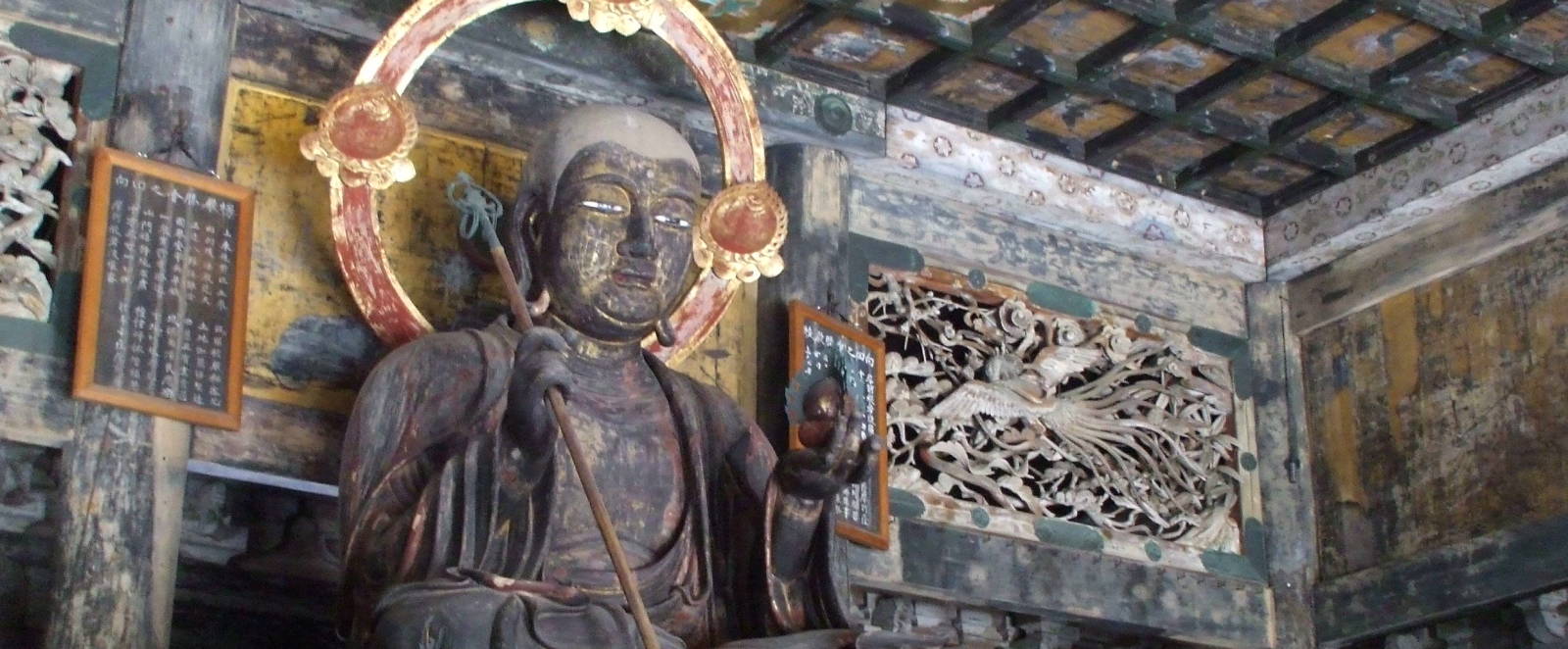
Kenchō-ji
Kenchō-ji, the First-Rank Zen Temple of Kamakura
Kenchō-ji is the oldest and most important of the "Five Great Mountains", the Zen Buddhist temples of Kamakura. It opened in Kenchō 5, the fifth year of the Kenchō era, which was 1253 CE in the western calendar. This is just about a year after the Daibutsu, the large bronze Buddha statue, was completed at the nearby Kōtoku-in temple.
Japanese Eras
Japanese era names are based on a calendar system that had been used in China since 140 BCE. In 645 CE in Japan, Prince Shōtoku had just died and the Soga clan had been defeated. Emperor Kōtoku had united Japan.
Emperor Kōtoku had decreed a sweeping set of reforms to centralize power in his imperial court. These reforms incorporated Confucian ideas and philosophies from China. He sent envoys and monks and students to China to learn their writing system, literature, religion, and many other components of culture.
These Chinese innovations included the calendar. In 645 CE Japan adopted China's era system. The Emperor decreed the first era as Taika.
Until the Emperor took back power from the Shōgunate over 1200 years later in 1868, the eras changed frequently. Imperial court officials would decide that it was time for a new era. They usually decreed a new era within the first year or two of a new Emperor's rule.
Then there is the sexagenary system of naming years in a 60-year cycle. The 1st, 5th, and 58th years of each cycle are considered to be inauspicious ones, so new eras usually would be decreed in those years.
On top of that, both good and bad events could trigger new eras. Especially felicitous events and natural disasters could lead to new eras, signaling that we're now in a much better new era, or we've left the disaster-filled previous era behind.
Since the Meiji Restoration of 1868, the eras are simply the Imperial reigns. The Emperor takes a "reign name" — he is known by the name his parents gave him at birth as long as he is alive, and then his posthumous name is his reign.
For example, the Emperor who was born in 1901 and then ruled Japan from 1926 to 1989 was known at the time as Emperor Hirohito, but now he and the period 1926-1989 are Shōwa.
His son Akihito, born in 1933, began the Heisei reign in 1989. After his abdication in April 2019, he and the period 1989-2019 are Heisei. Naruhito becomes Emperor and a new era begins.
Kenchō-ji Temple
Emperor Go-Fukukasa ordered the temple's construction, and it opened in 1253 CE. This makes it the oldest of the major Zen Buddhist temples of Kamakura. Rankei Doryū was the founding leader of the temple. He had been a Zen master in China, where he was known as Lan-hsi Tau-lung. He came to Japan in 1246. He spent a few years in Kyūshū and Kyōto before coming to Kamakura. One of his recorded sayings is:
If you have lost your true self, all phenomena bring you nothing but annoyance. If you discover your essence of mind, you can follow nothing but true path.
After his death, Emperor Go-Uda gave him the memorial title of Daikaku Zenji or "Teacher of Great Realization".
Kenchō-ji remains the oldest Zen training monastery in Japan. Kenchō-ji is the First Rank temple of the "Five Great Mountains" of Kamakura. Its temple bell is designated a National Treasure, and the temple complex and Tsurugaoka Hachiman-gū are the symbols of the city of Kamakura.
The Five Mountains and Ten Monasteries System
China's Song dynasty of 1127–1279 established the "Five Mountains and Ten Monasteries System". This was a network of state-sponsored Zen Buddhist temples. Japan's Kamakura Shōgunate adopted that system. They established ten "Five Mountain" temples in Japan. Five of them were in Kyōto and five were in Kamakura. There were ten smaller temples directly under those, and a much larger number of smaller temples further down.
The system's first goal was to promote Zen Buddhism across the country. However, just as in China, the network of temples quickly evolved into a governmental bureaucracy.
The top temples functioned as government ministries. The nation-wide network of temples distributed the laws. The Shōgunate controlled and stabilized the country through the temple network. Meanwhile the Rinzai sect of Zen Buddhism became powerful and wealthy.
The "Five Mountains" in Kamakura, the
Kamakura Gozan, were:
Kenchō-ji = First Rank
Engaku-ji = Second Rank
Jufuku-ji = Third Rank
Jōchi-ji = Fourth Rank
Jōmyō-ji = Fifth Rank
After Kamakura fell in 1333, the temples were recognized by the Emperor and supported and controlled by following Shōguns.
When the Ashikaga Shōgunate was dissolved in 1573, the Five Mountains system declined. Kenchō-ji had its own renaissance in the 19th century under the leadership of the Zen master Aozora Kandō.
Sanmon, the Main Gate
You enter the complex through the sōmon, the outer gate marking the first passage from the outside world into sacred space. That's where you buy your ticket for ¥300 or so.
A major temple like Kenchō-ji will then have a sanmon, a two-storied main gate. A sanmon or sangedatsumon, a "Gate of the Three Liberations", is the most important gate of a Zen Buddhist temple. It marks a further passage into increasingly sacred space and it leads to the Butsu-den, the Buddha Hall, the main hall of the complex.
O-tanuki-jinja, a raccoon-dog Shintō shrine in AsakusaThe current version of the sanmon of Kenchō-ji was built in 1754. The construction was funded by donations from all over the Kantō region. A popular legend says that a tanuki or raccoon-dog had been treated kindly by the temple's priests, so he transformed himself into a monk and helped to raise the money. Legends persist in Japan, so the gate is often informally called Tanuki-mon as in "raccoon-dog-gate".
The sanmon of a high-rank temple will have three gateway passages. These are the kūmon (or gate of emptiness), musōmon (or gate of formlessness), and muganmon (or gate of inaction). Those symbolize the three paths to satori or enlightenment.
The gate has entrances but there are no doors. You can pass through the gate but you can't close it. That emphasizes how the gate is just a symbolic boundary between the normal world and sacred space.
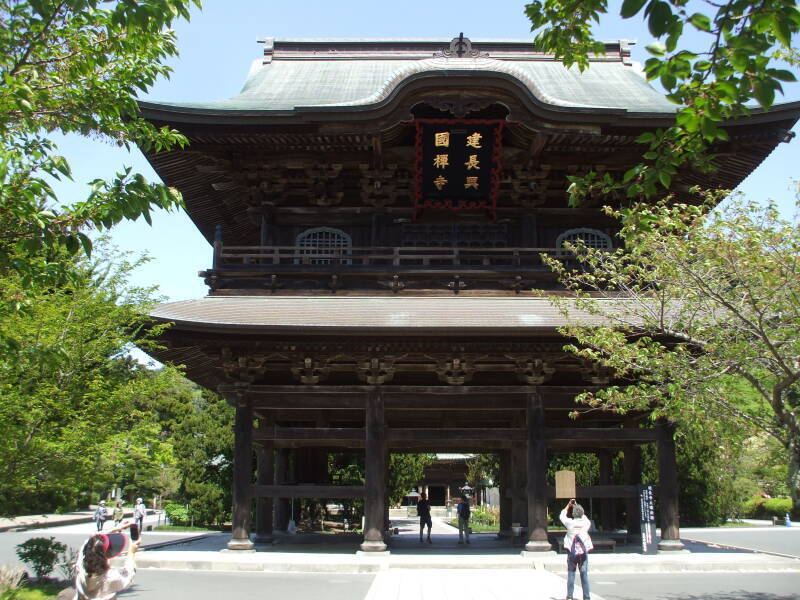
Butsu-den, the Hall of Buddha
The main hall is known as the Butsu-den. The juniper trees were planted in the 1200s from seeds Rankei Doryū brought from China.
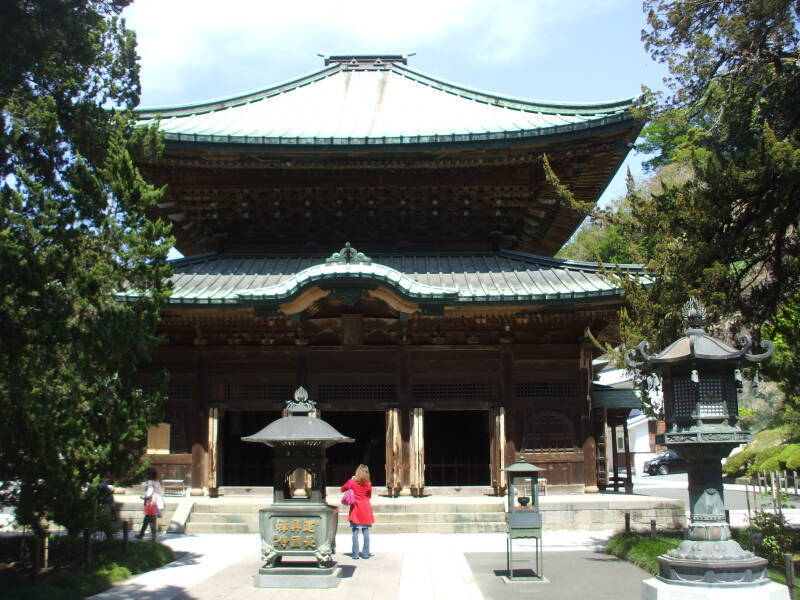
The Butsu-den houses a large wooden statue of the Bodhisattva Jizō seated upon a lotus blossom. The temple hall was originally built at Zōjō-ji in Tōkyō. It was disassembled and moved to Kamakura in 1647.


The Bonshō, the Temple Bell, is designated as a National Treasure. It was cast in 1255. It bears an inscription by Rankei Doryū, the monastery's founder.

Here we see the Butsu-den at right, and the Hattō or Dharma Hall at left. Public ceremonies and teaching sessions are held in the Dharma Hall.
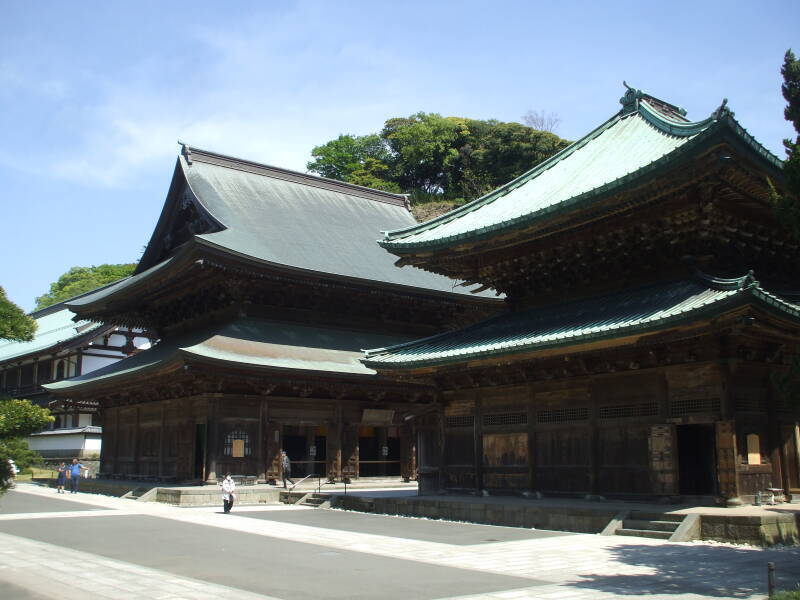
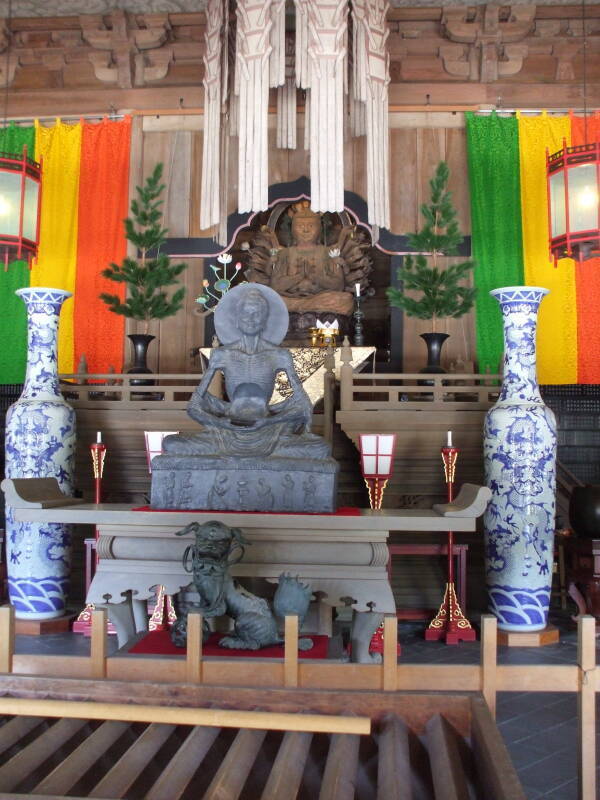
Continuing further beyond the Butsu-den and Dharma Hall we come to the Karamon or Grand Gate. It was also originally built at Zōjō-ji in Tōkyō, and moved to Kamakura in the 1640s.
Behind it and to its right are the buildings of the Hōjō, where the head priest once lived and where religious ceremonies are now held.
The Hōjō is often called Ryuo-den the Dragon King Hall. It enshrines an image of Shaka Nyorai, or Shakyamuni Buddha, the historical Buddha.


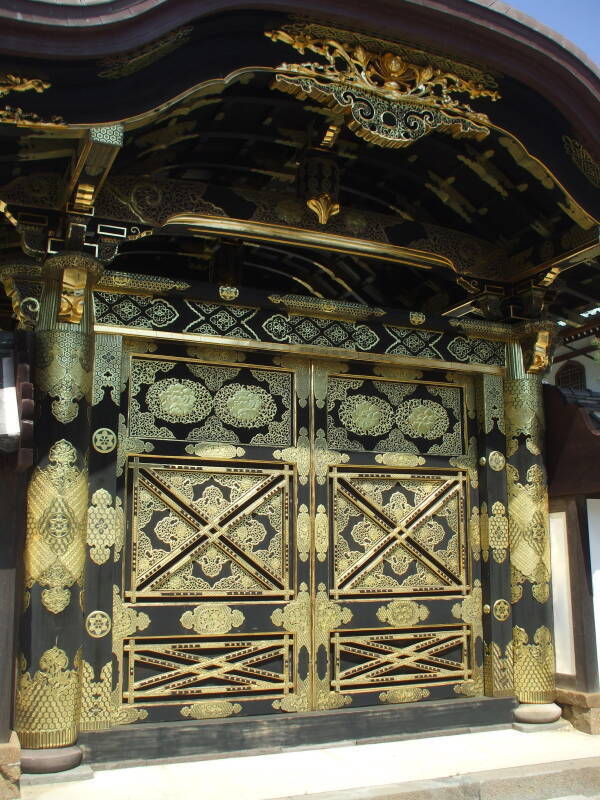
Here is one of the ceremonial halls in the Hōjō.


Continuing through the complex, there are gardens and more temples. The monks are trained in meditation in the monastery, which is closed to the public. It has a Zen-dō or Meditation Hall, a Kaisan-dō or Founder's Hall enshrining Rankei Doryū, the founding leader of the temple, and administrative offices.
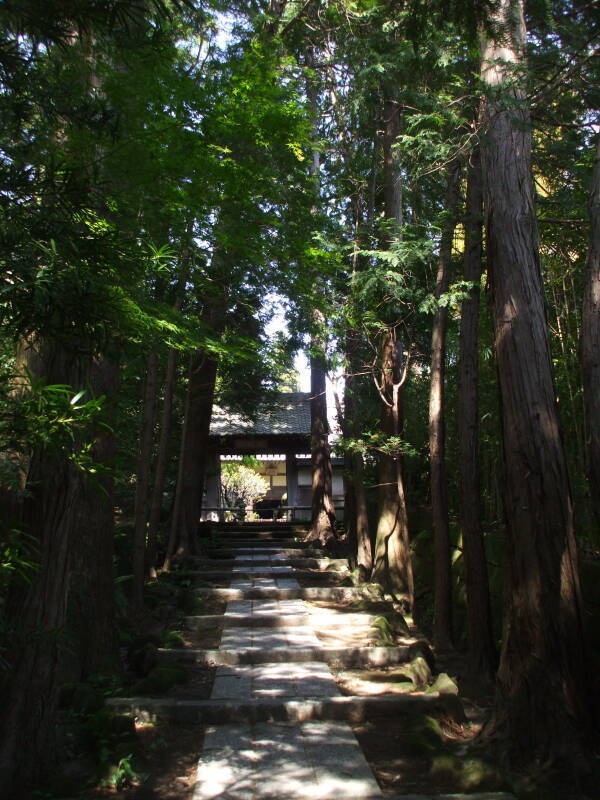
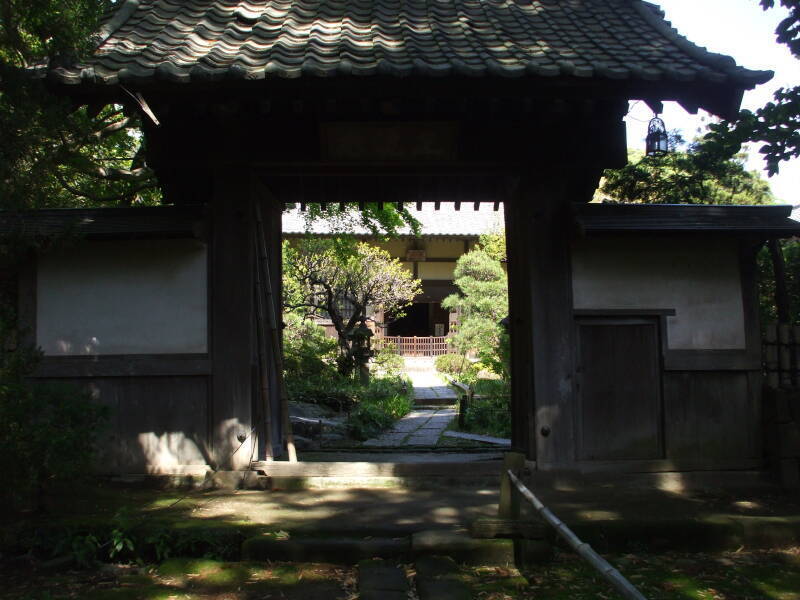
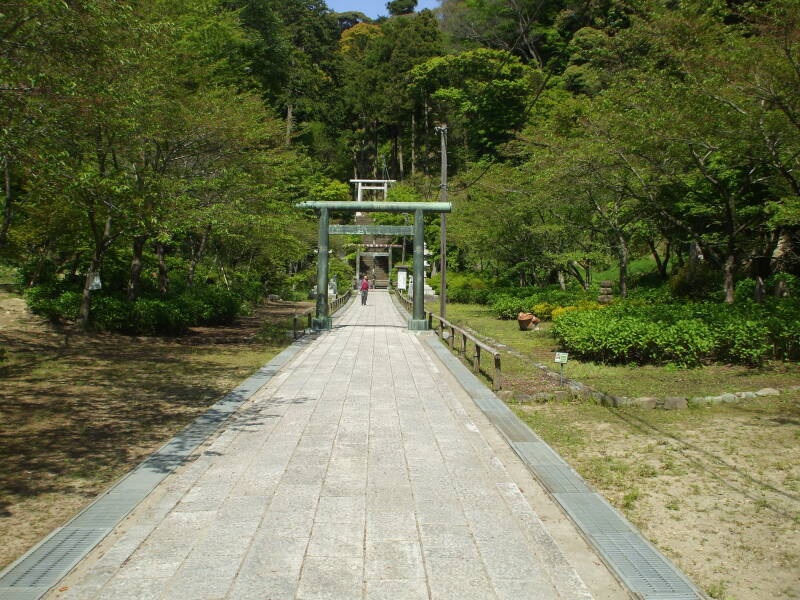
Continuing Beyond Kenchō-ji
There is a lot to see at Kenchō-ji. It originally had 49 subtemples in addition to the central Butsu-den. The sights continue beyond it. Above we're passing outward through the gardens at the rear of the temple complex. We're leaving the Zen Buddhist area as it blends into a Shintō shrine area overlooking Kenchō-ji.
The series of torii or gates mark passages into increasingly sacred space of a Shintō shrine. In the next page we will go up that hill to the Hansōbō Shrine, then continue along a path following the wooded ridgeline with several yagura cave tombs.
Next: Path around Kamakura with several yagura or rock-carved tombs » Or your choice:
The above is specific to Kamakura. Or maybe you want to explore other places in Japan.
Other topics in Japan:




































